Abstract
1. This study has explored the mechanism underlying the long duration of action of the beta 2-adrenoceptor agonist, salmeterol. 2. Salmeterol, salbutamol and isoprenaline caused a concentration-related inhibition of electrically-induced contractile responses of the guinea-pig superfused trachea preparation. The effects of both isoprenaline and salbutamol were rapid in onset and rapidly reversed upon removal of the agonist. In contrast, the effects of salmeterol were slower in onset and could not be reversed by superfusion of the tissue with agonist-free Krebs solution even for periods of up to 10 h. 3. The effects of salmeterol were, however, readily reversed by a number of beta-adrenoceptor blocking drugs, as was the effect of a continuous infusion of isoprenaline. Upon removal of the antagonist, however, the effects of salmeterol and of the isoprenaline infusion were reasserted at a rate which was inversely related to the lipophilicity of a beta-adrenoceptor blocking drugs. 4. Salmeterol inhibited the binding of [125I]-(-)-iodopindolol (100 pM) to rat lung membranes (pIC50 7.1), with isoprenaline (pIC50 6.2) and salbutamol (pIC50 5.1) having lower potencies. The inhibition of binding by salmeterol was apparently non-competitive, whereas that produced by salbutamol and isoprenaline was competitive in nature. 5. Isoprenaline and salbutamol rapidly dissociated from their binding sites, whereas in marked contrast, the binding of salmeterol showed no dissociation for periods of up to 1 h.(ABSTRACT TRUNCATED AT 250 WORDS)
Full text
PDF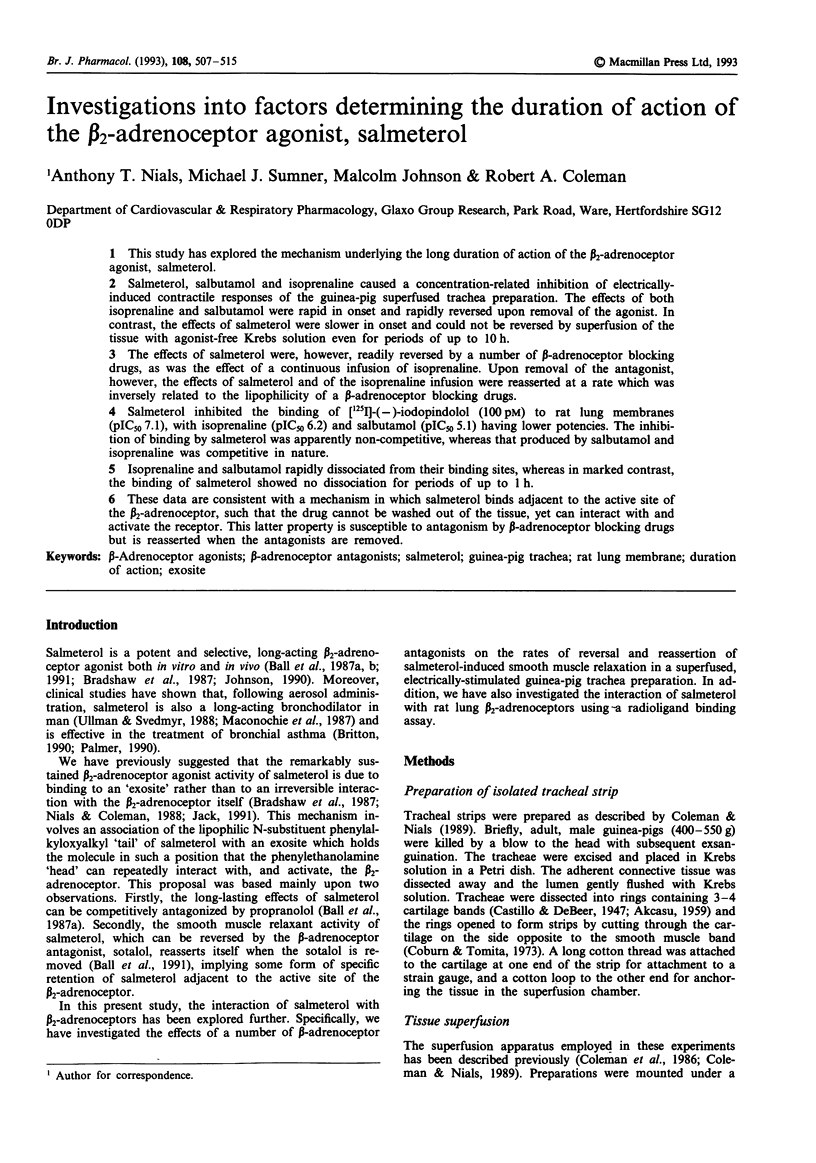
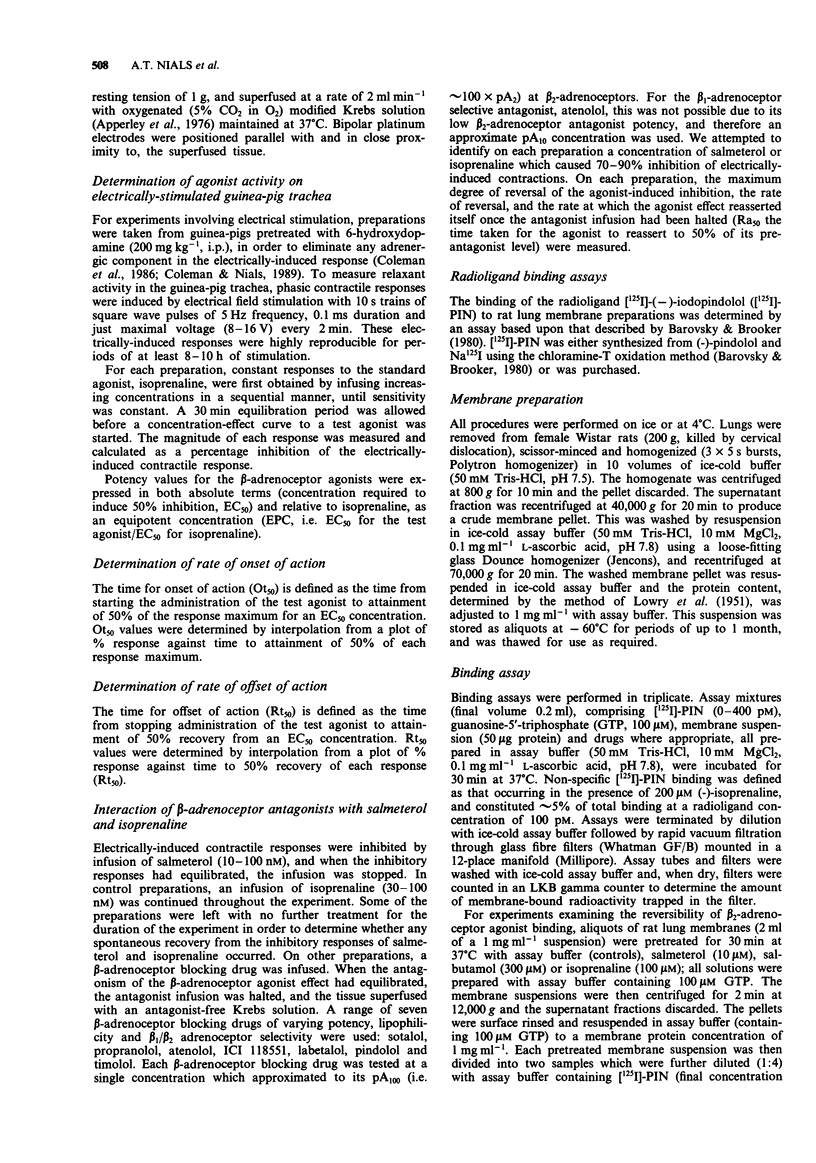
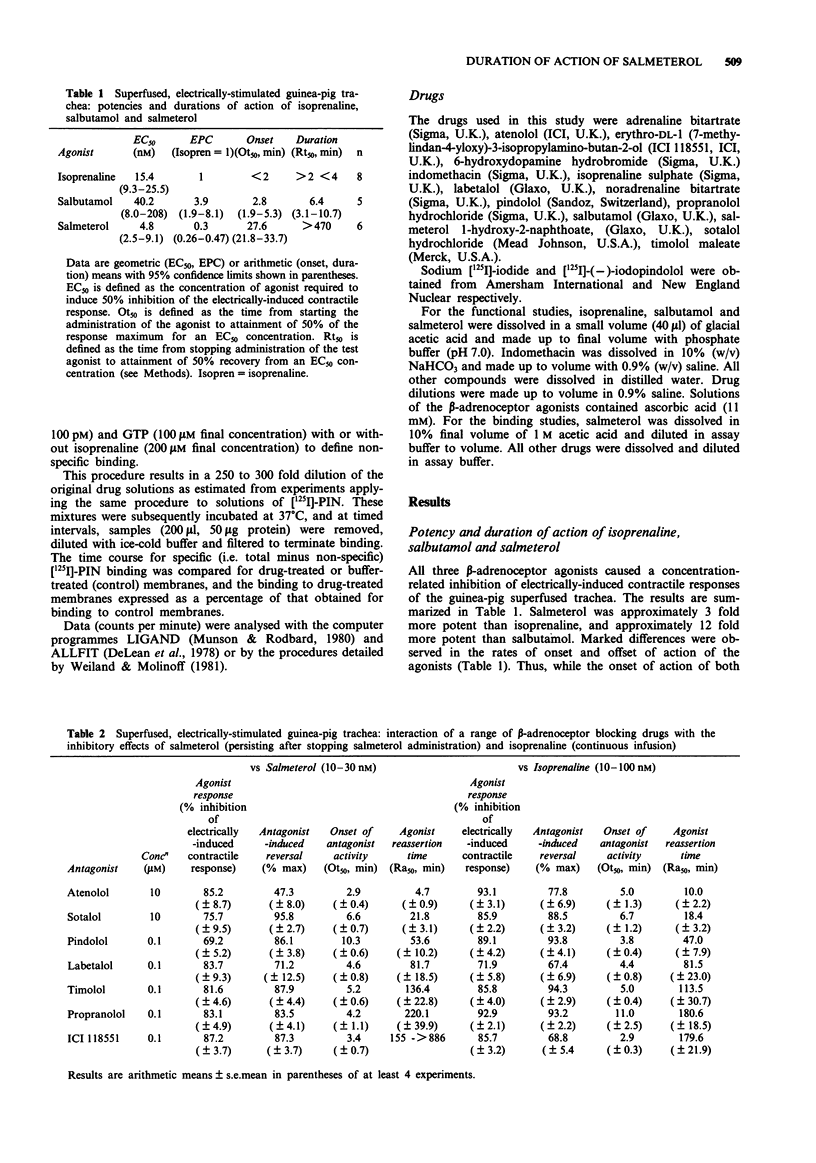


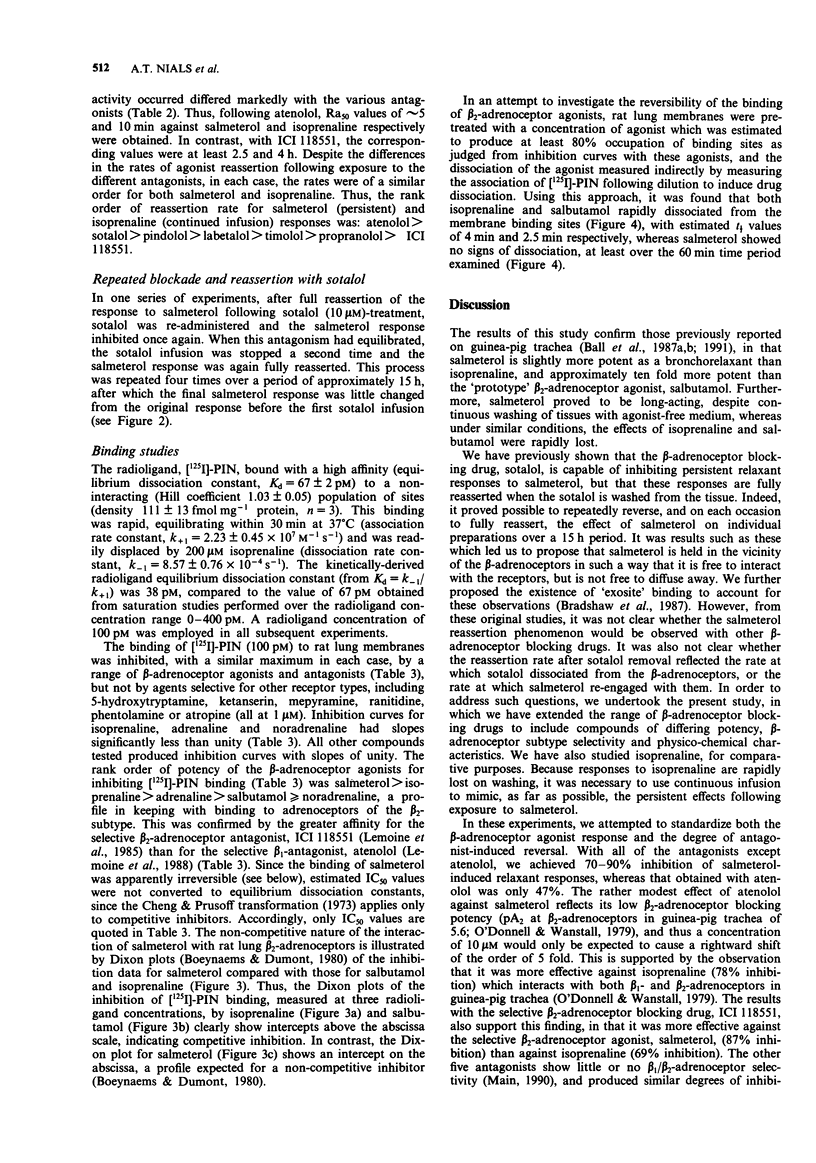

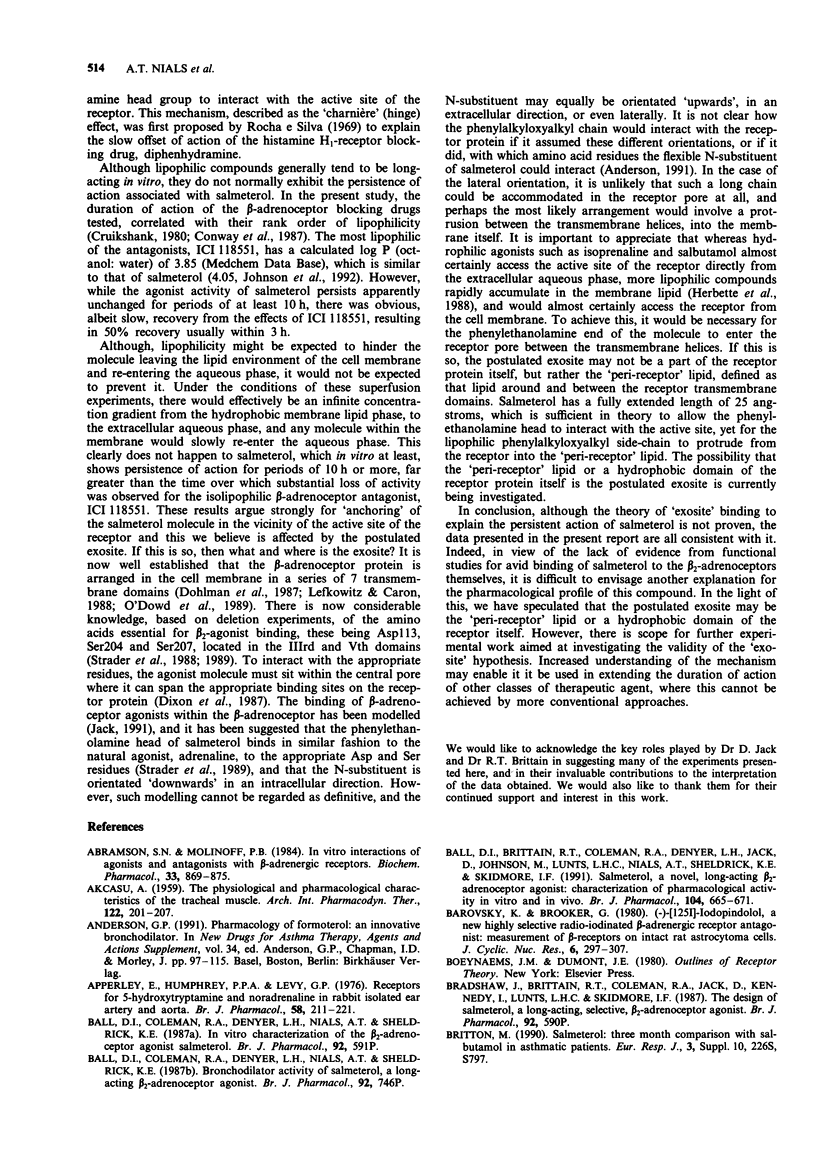
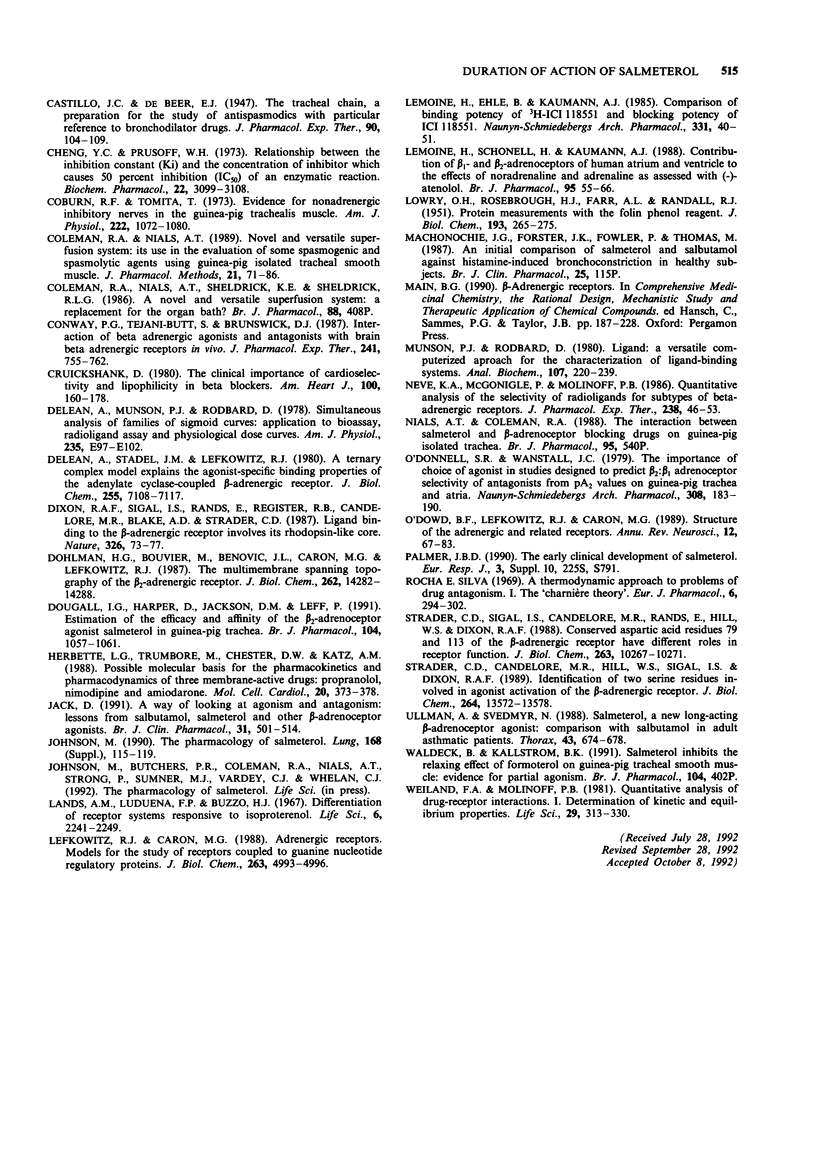
Selected References
These references are in PubMed. This may not be the complete list of references from this article.
- AKCASU A. The physiologic and pharmacologic characteristics of the tracheal muscle. Arch Int Pharmacodyn Ther. 1959 Oct 1;122:201–207. [PubMed] [Google Scholar]
- Abramson S. N., Molinoff P. B. In vitro interactions of agonists and antagonists with beta-adrenergic receptors. Biochem Pharmacol. 1984 Mar 15;33(6):869–875. doi: 10.1016/0006-2952(84)90440-4. [DOI] [PubMed] [Google Scholar]
- Anderson G. P. Pharmacology of formoterol: an innovative bronchodilator. Agents Actions Suppl. 1991;34:97–115. [PubMed] [Google Scholar]
- Apperley E., Humphrey P. P., Levy G. P. Receptors for 5-hydroxytryptamine and noradrenaline in rabbit isolated ear artery and aorta. Br J Pharmacol. 1976 Oct;58(2):211–221. doi: 10.1111/j.1476-5381.1976.tb10398.x. [DOI] [PMC free article] [PubMed] [Google Scholar]
- Ball D. I., Brittain R. T., Coleman R. A., Denyer L. H., Jack D., Johnson M., Lunts L. H., Nials A. T., Sheldrick K. E., Skidmore I. F. Salmeterol, a novel, long-acting beta 2-adrenoceptor agonist: characterization of pharmacological activity in vitro and in vivo. Br J Pharmacol. 1991 Nov;104(3):665–671. doi: 10.1111/j.1476-5381.1991.tb12486.x. [DOI] [PMC free article] [PubMed] [Google Scholar]
- Barovsky K., Brooker G. (-)-[125I]-iodopindolol, a new highly selective radioiodinated beta-adrenergic receptor antagonist: measurement of beta-receptors on intact rat astrocytoma cells. J Cyclic Nucleotide Res. 1980;6(4):297–307. [PubMed] [Google Scholar]
- Cheng Y., Prusoff W. H. Relationship between the inhibition constant (K1) and the concentration of inhibitor which causes 50 per cent inhibition (I50) of an enzymatic reaction. Biochem Pharmacol. 1973 Dec 1;22(23):3099–3108. doi: 10.1016/0006-2952(73)90196-2. [DOI] [PubMed] [Google Scholar]
- Coburn R. F., Tomita T. Evidence for nonadrenergic inhibitory nerves in the guinea pig trachealis muscle. Am J Physiol. 1973 May;224(5):1072–1080. doi: 10.1152/ajplegacy.1973.224.5.1072. [DOI] [PubMed] [Google Scholar]
- Coleman R. A., Nials A. T. Novel and versatile superfusion system. Its use in the evaluation of some spasmogenic and spasmolytic agents using guinea-pig isolated tracheal smooth muscle. J Pharmacol Methods. 1989 Mar;21(1):71–86. doi: 10.1016/0160-5402(89)90023-5. [DOI] [PubMed] [Google Scholar]
- Conway P. G., Tejani-Butt S., Brunswick D. J. Interaction of beta adrenergic agonists and antagonists with brain beta adrenergic receptors in vivo. J Pharmacol Exp Ther. 1987 Jun;241(3):755–762. [PubMed] [Google Scholar]
- Cruickshank J. M. The clinical importance of cardioselectivity and lipophilicity in beta blockers. Am Heart J. 1980 Aug;100(2):160–178. doi: 10.1016/0002-8703(80)90112-x. [DOI] [PubMed] [Google Scholar]
- De Lean A., Stadel J. M., Lefkowitz R. J. A ternary complex model explains the agonist-specific binding properties of the adenylate cyclase-coupled beta-adrenergic receptor. J Biol Chem. 1980 Aug 10;255(15):7108–7117. [PubMed] [Google Scholar]
- DeLean A., Munson P. J., Rodbard D. Simultaneous analysis of families of sigmoidal curves: application to bioassay, radioligand assay, and physiological dose-response curves. Am J Physiol. 1978 Aug;235(2):E97–102. doi: 10.1152/ajpendo.1978.235.2.E97. [DOI] [PubMed] [Google Scholar]
- Dixon R. A., Sigal I. S., Rands E., Register R. B., Candelore M. R., Blake A. D., Strader C. D. Ligand binding to the beta-adrenergic receptor involves its rhodopsin-like core. Nature. 1987 Mar 5;326(6108):73–77. doi: 10.1038/326073a0. [DOI] [PubMed] [Google Scholar]
- Dohlman H. G., Bouvier M., Benovic J. L., Caron M. G., Lefkowitz R. J. The multiple membrane spanning topography of the beta 2-adrenergic receptor. Localization of the sites of binding, glycosylation, and regulatory phosphorylation by limited proteolysis. J Biol Chem. 1987 Oct 15;262(29):14282–14288. [PubMed] [Google Scholar]
- Dougall I. G., Harper D., Jackson D. M., Leff P. Estimation of the efficacy and affinity of the beta 2-adrenoceptor agonist salmeterol in guinea-pig trachea. Br J Pharmacol. 1991 Dec;104(4):1057–1061. doi: 10.1111/j.1476-5381.1991.tb12549.x. [DOI] [PMC free article] [PubMed] [Google Scholar]
- Herbette L. G., Trumbore M., Chester D. W., Katz A. M. Possible molecular basis for the pharmacokinetics and pharmacodynamics of three membrane-active drugs: propranolol, nimodipine and amiodarone. J Mol Cell Cardiol. 1988 May;20(5):373–378. doi: 10.1016/s0022-2828(88)80128-7. [DOI] [PubMed] [Google Scholar]
- Jack D. The 1990 Lilly Prize Lecture. A way of looking at agonism and antagonism: lessons from salbutamol, salmeterol and other beta-adrenoceptor agonists. Br J Clin Pharmacol. 1991 May;31(5):501–514. doi: 10.1111/j.1365-2125.1991.tb05571.x. [DOI] [PMC free article] [PubMed] [Google Scholar]
- Johnson M. The pharmacology of salmeterol. Lung. 1990;168 (Suppl):115–119. doi: 10.1007/BF02718123. [DOI] [PubMed] [Google Scholar]
- LOWRY O. H., ROSEBROUGH N. J., FARR A. L., RANDALL R. J. Protein measurement with the Folin phenol reagent. J Biol Chem. 1951 Nov;193(1):265–275. [PubMed] [Google Scholar]
- Lands A. M., Luduena F. P., Buzzo H. J. Differentiation of receptors responsive to isoproterenol. Life Sci. 1967 Nov 1;6(21):2241–2249. doi: 10.1016/0024-3205(67)90031-8. [DOI] [PubMed] [Google Scholar]
- Lefkowitz R. J., Caron M. G. Adrenergic receptors. Models for the study of receptors coupled to guanine nucleotide regulatory proteins. J Biol Chem. 1988 Apr 15;263(11):4993–4996. [PubMed] [Google Scholar]
- Lemoine H., Ehle B., Kaumann A. J. Direct labelling of beta 2-adrenoceptors. Comparison of binding potency of 3H-ICI 118,551 and blocking potency of ICI 118,551. Naunyn Schmiedebergs Arch Pharmacol. 1985 Oct;331(1):40–51. doi: 10.1007/BF00498850. [DOI] [PubMed] [Google Scholar]
- Lemoine H., Schönell H., Kaumann A. J. Contribution of beta 1- and beta 2-adrenoceptors of human atrium and ventricle to the effects of noradrenaline and adrenaline as assessed with (-)-atenolol. Br J Pharmacol. 1988 Sep;95(1):55–66. doi: 10.1111/j.1476-5381.1988.tb16548.x. [DOI] [PMC free article] [PubMed] [Google Scholar]
- Munson P. J., Rodbard D. Ligand: a versatile computerized approach for characterization of ligand-binding systems. Anal Biochem. 1980 Sep 1;107(1):220–239. doi: 10.1016/0003-2697(80)90515-1. [DOI] [PubMed] [Google Scholar]
- Neve K. A., McGonigle P., Molinoff P. B. Quantitative analysis of the selectivity of radioligands for subtypes of beta adrenergic receptors. J Pharmacol Exp Ther. 1986 Jul;238(1):46–53. [PubMed] [Google Scholar]
- O'Donnell S. R., Wanstall J. C. The importance of choice of agonist in studies designed to predict beta 2 : beta 1 adrenoceptor selectivity of antagonists from pA2 values on guinea-pig trachea and atria. Naunyn Schmiedebergs Arch Pharmacol. 1979 Sep;308(3):183–190. doi: 10.1007/BF00501381. [DOI] [PubMed] [Google Scholar]
- O'Dowd B. F., Lefkowitz R. J., Caron M. G. Structure of the adrenergic and related receptors. Annu Rev Neurosci. 1989;12:67–83. doi: 10.1146/annurev.ne.12.030189.000435. [DOI] [PubMed] [Google Scholar]
- Rocha e Silva A thermodynamic approach to problems of drug antagonism I. The "Charnière theory". Eur J Pharmacol. 1969;6(3):294–302. doi: 10.1016/0014-2999(69)90188-5. [DOI] [PubMed] [Google Scholar]
- Strader C. D., Candelore M. R., Hill W. S., Sigal I. S., Dixon R. A. Identification of two serine residues involved in agonist activation of the beta-adrenergic receptor. J Biol Chem. 1989 Aug 15;264(23):13572–13578. [PubMed] [Google Scholar]
- Strader C. D., Sigal I. S., Candelore M. R., Rands E., Hill W. S., Dixon R. A. Conserved aspartic acid residues 79 and 113 of the beta-adrenergic receptor have different roles in receptor function. J Biol Chem. 1988 Jul 25;263(21):10267–10271. [PubMed] [Google Scholar]
- Ullman A., Svedmyr N. Salmeterol, a new long acting inhaled beta 2 adrenoceptor agonist: comparison with salbutamol in adult asthmatic patients. Thorax. 1988 Sep;43(9):674–678. doi: 10.1136/thx.43.9.674. [DOI] [PMC free article] [PubMed] [Google Scholar]
- Weiland G. A., Molinoff P. B. Quantitative analysis of drug-receptor interactions: I. Determination of kinetic and equilibrium properties. Life Sci. 1981 Jul 27;29(4):313–330. doi: 10.1016/0024-3205(81)90324-6. [DOI] [PubMed] [Google Scholar]


